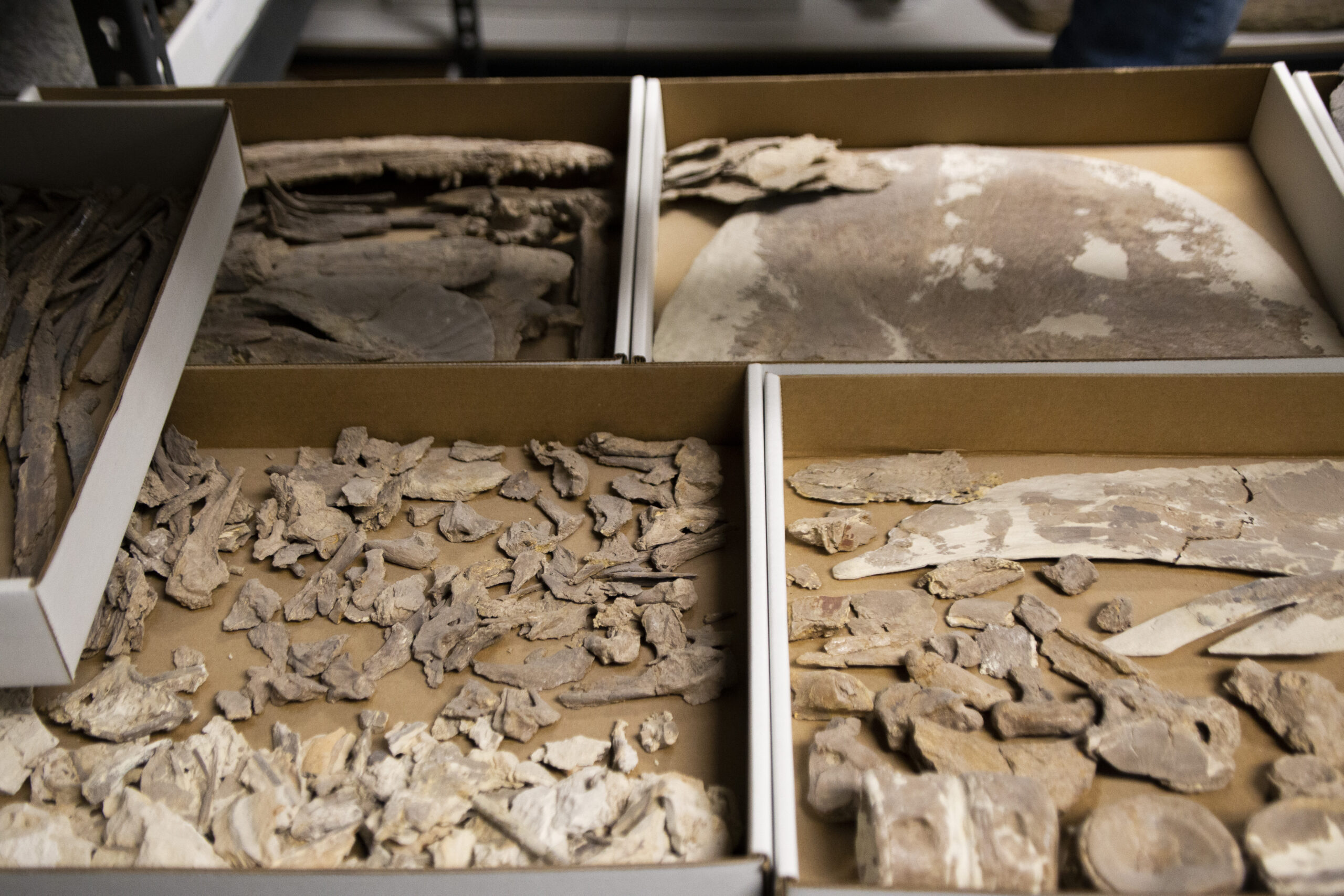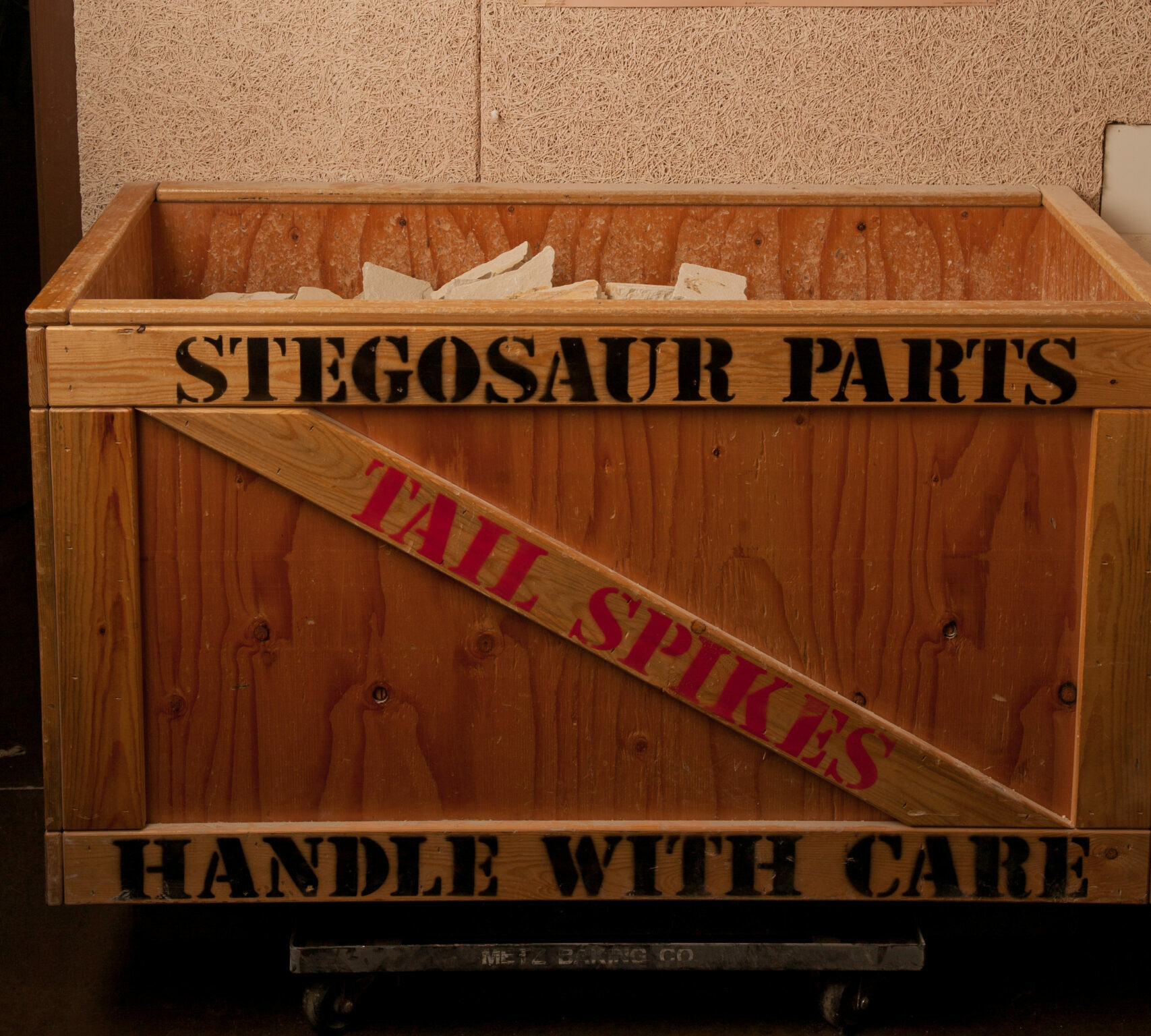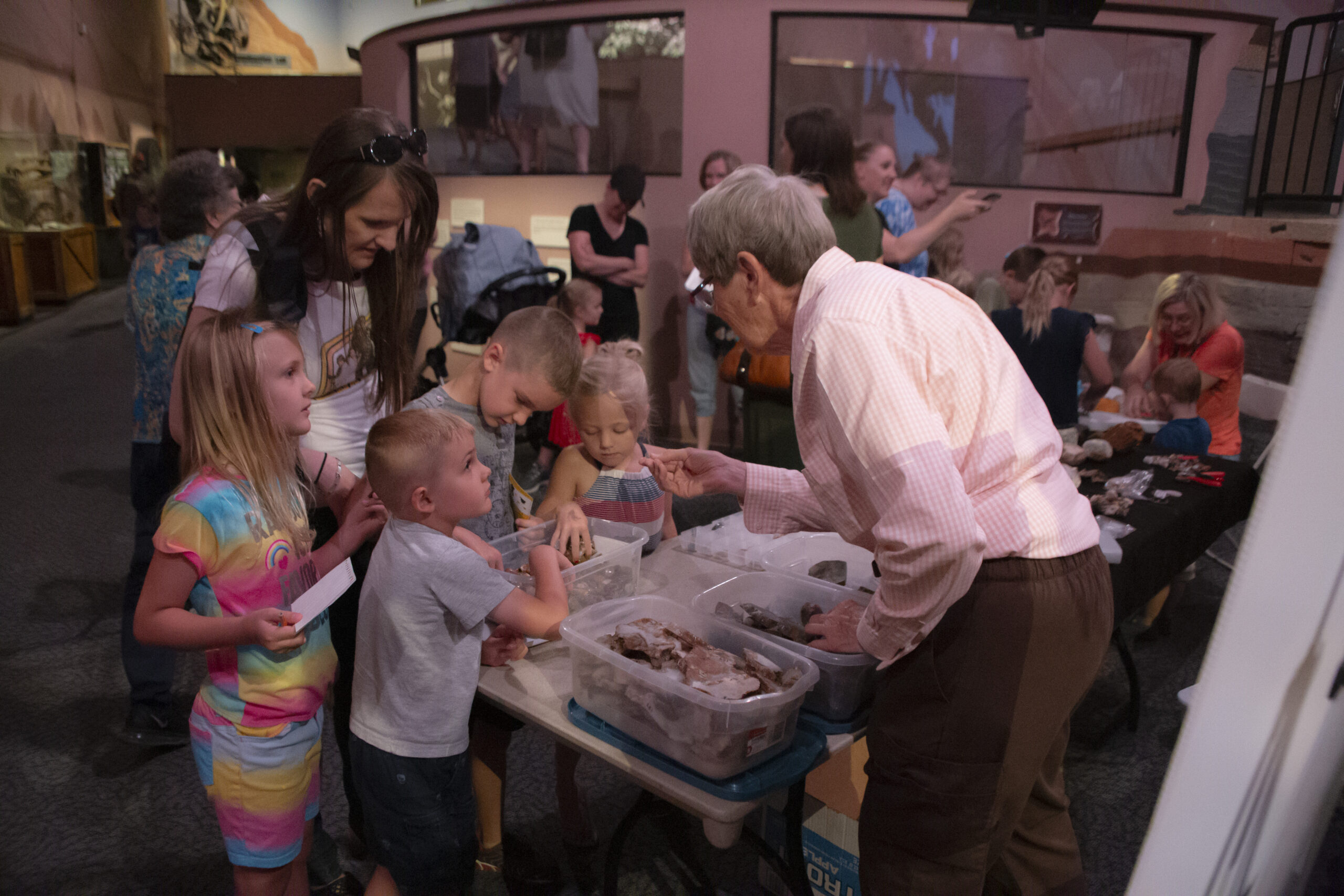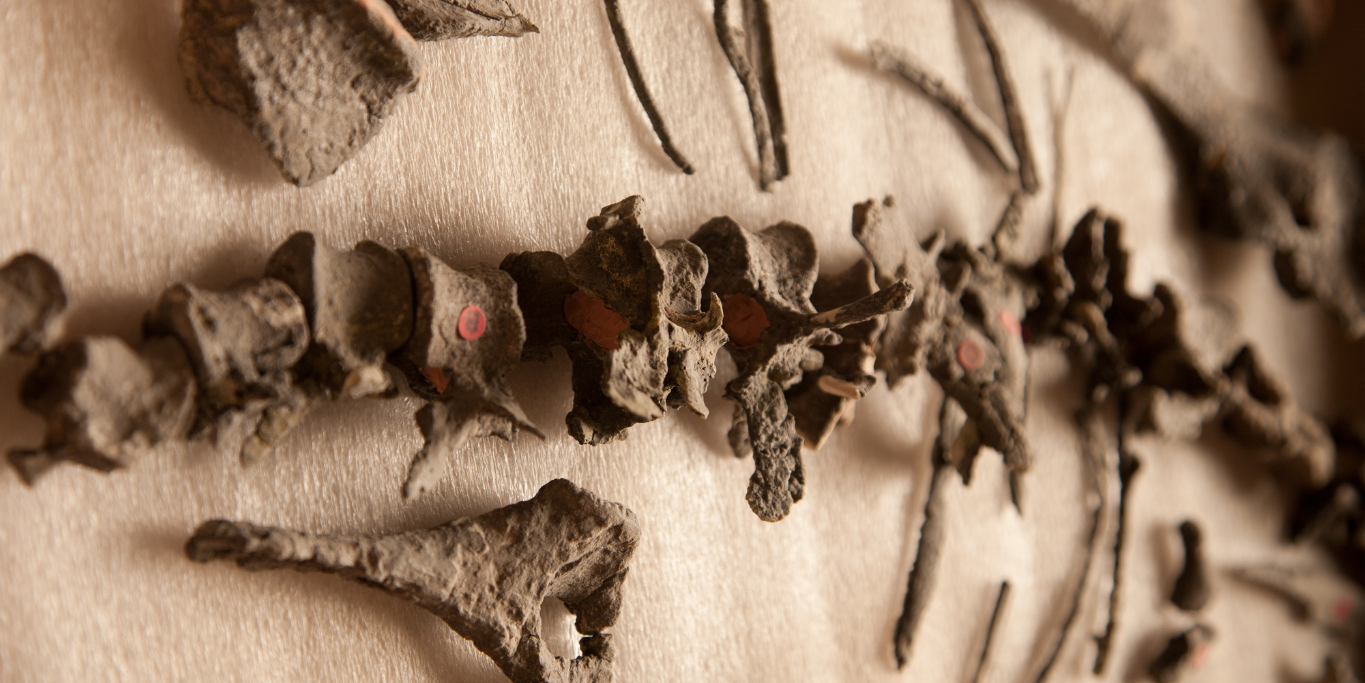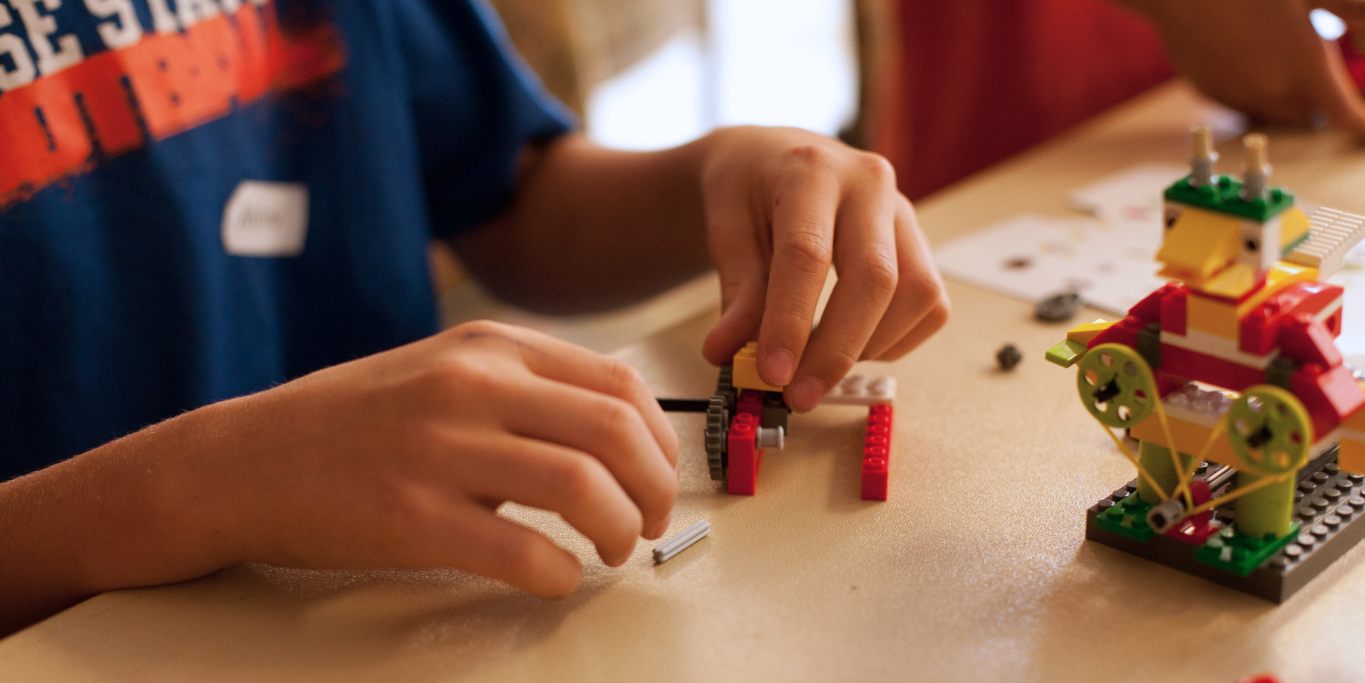It is quiet. The researcher sits in the lab looking over the Barosaurus bones and all you can hear, every once in a while, is his soft exclamation of wonder at fossils laid before him. “Wow,” he says. Silence again until a few minutes later, “Wow.” He tells Liz, “Do you know how lucky you are to work here?” He tells her how rare some of the things in the museum are, how rare it is to have so many skeletal mounts, how rare it is to be able to get so close and see things and walk under things and to have all those elements all in one place. She smiles, “Oh trust me, I know.” She should know, after all, she is the one who counts and takes care of every piece in the museum.
Liz Anderson is the Collections Manager at the Mountain America Museum of Ancient Life, though museum collections work was not her original plan. Liz studied anthropology, the study of human societies and cultures and their development, and after her undergraduate, began working in the field. She was doing collections work for a private company and was surprised by how much she enjoyed organizing and cataloging in a nice, cool museum instead of working out on-site in the hot sun in the middle of nowhere. Liz says, “I would rather work in a museum and organize because I’m like that in my life – I have one of those memories where my husband would go, “Have you seen my old glasses from two years ago? and I’ll be like, “The last time I saw them they were in this closet on this shelf”, and then he’ll go there and they’re there.” She can remember where things are, and the history and the details involved with them, and she realized collections were a better fit.
Now she spends her days in the paleo lab, doing what collections managers do best – a hundred different things. “We wear a lot of hats. My main duty is to catalog and inventory our collection. So, that would mean identifying objects, labeling them, cleaning, repairing them, and then storing them correctly, and digitizing our collections.”
Identifying: The Museum of Ancient Life currently has three collections – The teaching collection, which was donated in 2014 and contains over 2,600 specimens; the exhibits collection, which is everything the public can see and contains between 2,000 and 6,000 specimens; and everything that is in the collections room which has not been counted yet. Liz estimates it to be between 600 and 2,000 specimens. For inventory, everything must be counted and identified. Liz identifies specimens by sorting them into groups. “They all fit into these different classifications – you know, kingdom, phylum, – and as you go down it becomes more refined. You would find that there would be one thing in one group and as it branched out there were all these other things as well, so we would discover that these four items are the same as this item and they all go together.” Liz says that a lot of time gets devoted to research because when it comes to identification there are so many layers and possibilities. Trouble also comes when a specimen is fragmented. There could be a box full of 50 different pieces and they could be separate specimens, or one single specimen all broken up. If it is the latter, it must be put back together again before it even becomes identifiable.
Cleaning and Repairing: Once the specimens are identified, they are then cleaned. Fossils are extremely fragile and must be treated with the utmost care. They are in good hands with Liz. Sometimes though, things happen, and those things are treated as learning experiences. Liz says that when the teaching collection was donated there was palm fruit included in the collection that had fossilized in a sulfuric layer, so it was pyritized and unstable. When the collections team cleaned it, the sulfur and the acid began to break down the fossil and it burned them. This led to the discovery that anything pyritized cannot get wet. She says, “we learned the hard way”, but they now adjust accordingly. Just like with every other step, they also do research to make sure everything is being cleaned correctly. Liz carefully washes and cleans each specimen in the lab and assists Rick Hunter, our Director of Paleontology, with any repairs that need to be done, while other members of the museum staff carefully clean the exhibits that are on display.
Labeling: Specimens are labeled by year, group number, and item number. She says that they often work with the Natural History Museum in Salt Lake, and they talk to each other about how each museum labels its specimens to ensure accurate and thorough information. A good labeling system (and good labels) gives you a good visual organization of everything the museum holds. What is Liz’s favorite thing found in the museum? The gastroliths. Gastroliths are found in a dinosaur’s stomach and indicate that some dinosaurs with high-fiber diets would eat rocks to help them digest. Modern birds do this as well. Liz says, “It just brings it to life and says like, these were real creatures that really lived. It connects the past with the present and I just think that’s so cool.”
Digitizing: Digitizing is important because it allows more people to have access to the Museum of Ancient Life’s collections. It’s a big task – it took four years to process and digitize the whole teaching collection. Once specimens are labeled, pictures are taken and the data (what they look like, where they’re from, what they are, what taxonomic group they fit into etc.) is imputed into an online database. Liz also tries to include cool facts or bits of stories or history that add a unique element to the specimen – like how the Church of Jesus Christ of Latter-Day Saints shipped limestone from Utah to Washington D.C. to build a church and over the years, the rain caused the limestone to crumble and inside the limestone was bird’s eye algae that contained fossils inside them. “You’ll have something like algae which people say, “why do I care about algae, it’s just a kind of bacteria right,” but then you learn that in DC there’s a church made of fossils, which is crazy. But you wouldn’t be interested in these little nodules if you didn’t understand the context. So, a lot of times we try to collect those interesting facts or stories or histories and help people understand how things are connected.”
While not yet accessible to the public, this database is often utilized by our Learning & Engagement team, who can check out fossils and use the information that is listed to teach guests and students all over Utah all about all the incredible things housed in our museum.
Storing: Research strikes again! What does Liz do before she stores something? She researches the way it should be stored.She says, “It’s kind of nice, because with Archeology and Paleontology, really any kind of collection, the work is the same. It’s just a different material. So, it’s just how do I store a painting vs how do I store a fossil? You learn the proper storage techniques and then you apply that to whatever you’re working on. How do you store bones? How do you store different kinds of bones? Do we need field jackets? Can we use boxes? What are our options?” Right now, they primarily use cardboard and foam, but as time goes on, the amount of storage options is sure to increase. They also swap tips with the Natural History Museum when it comes to storing and a new collections room is being built that will have more cabinets and more space to store specimens.
Our collections team, acting as stewards for our fossils and artifacts, help make the Mountain America Museum of Ancient Life a place where families can learn about the natural world, millions of years ago to today. Liz says, “Most institutions have a policy, and usually it is a set of guidelines and rules of how the museum operates. One of the main guidelines that every institution has is that the collection is cared for and preserved in perpetuity for access to the general public.” She says it is like a promise made to the public – you, the state, the government, or a private individual will give us funding, and in return, we protect our specimens so you can come and see them. Liz abides by that overarching promise – that she will protect and preserve the items in her care for public benefit and education. Having a collections manager and an organized collection is also important for insurance purposes. If for any reason, a natural disaster or any mishap occurs, having a collection digitized in a database helps prove that we have what we say we have and we can show what state they were in, where they were in the museum, and so on. Also, if anything goes missing for any reason, redundant systems for organizing and checking out are in place to increase the chances of recovering that item.
Liz is currently getting a master’s degree in Collections Care and Management and is always applying the things she is learning to the museum’s collection – even if that means beginning a section over again. We are grateful that our specimens are so well taken care of and that we have a collections manager who works so diligently under the belief that “all people deserve to walk among dinosaurs.”
